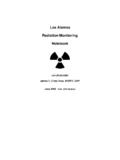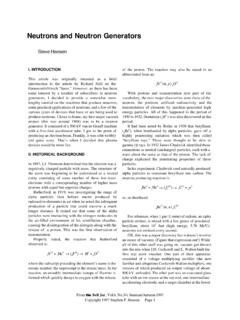Transcription of EXAMINATION PREPARATION GUIDE
1 (Rev. 4/09) EXAMINATION PREPARATION GUIDE Revised - June 2011 Definition of a radiation protection Technologist A radiation protection Technologist is a person engaged in providing radiation protection to the radiation worker, the general public, and the environment from the effects of ionizing radiation . The radiation protection Technologist has a basic understanding of the natural laws of ionizing radiation , the mechanisms of radiation damage, methods of detection, and hazards assessment. The radiation protection Technologists tasks are accomplished by providing supervisory, administrative, and/or physical controls, utilizing sound health physics principles in compliance with local and statutory requirements and accepted industry practices. The radiation protection Technologist mitigates hazards associated with radioactive materials and ionizing radiation producing devices, always adhering to the As Low As Reasonably Achievable philosophy.
2 National Registry of radiation protection Technologists Box 3084, Westerly, RI 02891 (401) 637-4811 (ofc)(401) 637-4822 (fax)(Rev. 4/09) AN IMPORTANT MESSAGE TO CANDIDATES This GUIDE will help you prepare for the National Registry of radiation protection Technologists (NRRPT) EXAMINATION . The GUIDE , however will not be the key to a good grade on the EXAMINATION . Successful candidates generally prepare for months prior to the test. They cover the fundamental and applied aspects of radiation protection through the use of textbooks and by joining study groups. The Board cautions against approaching the exam in a casual fashion. We believe that all applicants declared eligible to take the EXAMINATION , after careful review of credentials, have a good probability of passing. You can avoid the disappointment of poor performance by recognizing at the start that the exam will be an all encompassing, rigorous test of radiation protection knowledge.
3 Your performance will, for the most part, depend on the thoroughness of your PREPARATION . Now that you are aware of the key to good performance on the EXAMINATION , we wish you success in achieving Registration. (Rev. 4/09) CONTENTS OF THE NRRPT EXAMINATION The EXAMINATION consists of 150 multiple choice questions from three general categories: Applied radiation protection , Detection and Measurement, and Fundamentals. Four hours are allowed for the exam. Past examinations are not released. Typical questions are included in this GUIDE , however the candidate needs to be aware that these questions do not represent a typical mix of questions on an actual exam. We believe that it is advantageous to develop a plan for PREPARATION and to approach the exam in an organized manner. Some suggestions for taking the exam are listed below. 1. Budget your time so that you are answering approximately 40 questions/hour. 2. Start at the beginning of the exam and work through it in sequential order, answering questions you are sure of.
4 Save the difficult ones for the end, making sure you don t get your answers out of sequence on the answer sheet. 3. Read each question and each answer carefully. 4. There is no penalty for wrong answers, so make sure you answer every question. Further information about the National Registry of radiation protection Technologists EXAMINATION can be obtained from: NRRPT Box 3084 Westerly, RI 02891 (401) 637-4811 (401) 637-4822 (fax) (email)(Rev. 4/09) TYPICAL EXAMINATION QUESTIONS 1. In general, the body cells most susceptible to damage by radiation are those found in: a.
5 Rigid or semi rigid tissues b. muscle tissues c. rapidly dividing tissues d. highly specialized tissues e. nerve tissues 2. In a picocurie of any radioactive substance, the disintegration rate is: a. dpm b. x 10 E 6 dpm c. 37,000,000 dpm d. x 10 E 4 dps e. x 10 E 10 dps 3. Which of the following radionuclides cannot be detected by gamma spectrometry pulse height analysis? a. Hydrogen-3 b. Iodine-131 c. Cerium-144 d. Ruthenium-106 e. Cesium-137 4. The elemental symbols for Boron, Beryllium, Cadmium, and Calcium are: a. Bo, B, Ca, C b. B, By, Cd, Ca c. Bo, Be, Cd, Ca d. B, Be, Cd, Ca e. B, Br, Ca, Cl 5. Which of the following radionuclides is most suited to in-vivo measurements? a. Hydrogen-3 b.
6 Carbon-14 c. Strontium-90 d. Iodine-131 e. Plutonium-239 6. How long must a sample with a count rate of 300 cpm be counted to give a total count rate standard deviation of 1%? a. min b. 17 min c. 30 min d. 33 min e. 65 min 7. At what radius would you post a radiation area around an 8 curie Cesium 137 (662 Kev photon energy and a photon yield of photons/disintegration) point source? a. 10 feet b. 74 feet c. 145 feet d. 53 feet e. 101 feet (Rev. 4/09) 8. An air filter with a collection efficiency of is being used in a decontamination effort. Calculate the decontamination factor for this filter. a. 9997 b. c.
7 3000 d. 10,000 e. 3333 9. During an emergency in a DOE regulated facility, with known or potential high radiation fields, exposure to personnel must be voluntary if it is anticipated that such exposure may exceed a whole body exposure of: a. 5 rem b. 10 rem c. 25 rem d. 75 rem e. 100 rem 10. A worker is to perform maintenance on a Reactor Coolant pump under the following radiological conditions; Dose rate on contact with the pump - 350 mrem/hr, Dose rate at 30 cm from the pump (working area dose rate) is 85 mrem/hr, and an airborne concentration of .45 DAC. She will spend a maximum of 14 hours in this area during the week. According to 10 CFR20, how is this area to be posted? a. Danger High radiation Area, Airborne Radioactivity Area b. Caution radiation Area, Airborne Radioactivity Area c.
8 Caution High radiation Area, Airborne Radioactivity Area d. Caution Airborne Radioactivity Area e. Caution radiation Area 11. For an exclusive use vehicle that is transporting radioactive materials, radiation levels on contact with any external surface of the vehicle must not exceed: a. mSv/hour b. mSv/hour c. mSv/hour d. mSv/hour e. mSv/hour 12. Two categories of ionization are: a. alpha and beta b. direct and indirect c. microwave and infrared d. charged and uncharged e. molecular and atomic 13. Intrinsic efficiency of a detector expresses the: a. probability that a count will be recorded if radiation enters the sensitive volume. b. ability of an instrument to count different energies. c. percent of gamma energy producing ion pairs.
9 D. total detector counts minus the background. e. total beta/gamma counts by a tissue equivalent detector 14. The antiparticle of a positron is a: a. proton b. neutrino c. electron d. meson e. neutron (Rev. 4/09) 15. Forms of the same chemical element that contain different numbers of neutrons are called: a. isobars b. isomers c. radionuclides d. isotones e. isotopes 16. An atom of a radionuclide that has a low neutron to proton ratio, and an atomic rest mass energy that is Mev greater than the product atom s rest mass energy may decay by which of the following? a. Either positron emission or electron capture b. Annihilation c. Beta minus emission d. Isomeric transition e.
10 Internal conversion 17. Which radioactive decay series includes Ra-226 as one of its decay products? a. Thorium b. Uranium c. Actinium d. Neptunium e. Polonium 18. An individual who receives an acute, whole body (DDE) radiation exposure of approximately 8Gy will likely suffer symptoms of up to which level of the Acute radiation Syndrome? a. Subclinical b. Hemopoietic c. Gastrointestinal d. Central Nervous System e. Not enough exposure to classify 19. The term isokinetic sampling refers to the procedure of using sampling velocity that is exactly equal to the: a. velocity of the gas stream at the point of sampling b. velocity at the center of the main gas stream corrected for temperature and pressure c. velocity at the center of the main gas stream d. velocity of the gas stream adjacent to the duct wall e.








